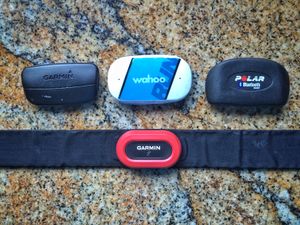Difference between revisions of "Wahoo TICKR Run"
From Fellrnr.com, Running tips
User:Fellrnr (User talk:Fellrnr | contribs) (Created page with "{{DISPLAYTITLE:Wahoo TICKR Run Review}} File:TICKR Front.jpg|right|thumb|300px|The Wahoo TICKR sensor (top center) with the older Garmin HRM (top left), Polar (top right), a...") |
(No difference)
|
Revision as of 16:35, 11 August 2016

The Wahoo TICKR sensor (top center) with the older Garmin HRM (top left), Polar (top right), and the latest Garmin Running Dynamics HRM (bottom).
The Wahoo TICKR Run is a heart rate monitor strap that will work with most Running Watches. It supports both of the major standards, Bluetooth and Ant+, as well as supporting some interesting extra running metrics. The most interesting is their measure of smoothness, which has the potential to give useful feedback on running form. I think the TICKR is a good buy, though if you have a Garmin watch that supports it, their Running Dynamics heart rate strap might be a better option. The Wahoo TICKR Run is Error: Could not parse data from Amazon!.
- The Ant+ support allows the TICKR to work with Garmin running watches, as well as some others like the older Suunto Amibt2. In Ant+ mode it will only provide Heart Rate data, not any of the other additional functions (including Cadence).
- The Bluetooth transmission will work with a Smartphone as well as many other companies running watches. However, Bluetooth will only work with one device at a time, so you can't use it with a Smartphone and a running watch concurrently. If you're using a watch, the Bluetooth will only provide heart rate data.
- If you use the Wahoo app, you can get a number of additional running metrics. The TICRK will work with many other smartphone apps, but those other apps will only get the heart rate data.
- Rather like Garmin's Running Dynamics the TICKR will provide both Ground Contact Time and Vertical Oscillation.
- Cadence. This is probably the single most important metric in running, and this approach is more accurate than using the accelerometer built into a watch itself.
- Vertical Oscillation. This is how much the torso moves up and down with each stride. It is generally believed that less Vertical Oscillation is a better, but I suspect that this is an oversimplification. Some are part of a runner's vertical movement is likely to be elastic in nature (consider a bouncing rubber ball), some of the vertical motion will be while the runner is airborne (ballistic), and some of the vertical motion is the deceleration as the runner lands. So it seems likely to me that excessive vertical oscillation is bad, but it's a tricky to know what excessive is likely to be, or how to correct it.
- Ground Contact Time (GCT). The Science of Running Economy generally shows that longer Ground Contact Time is correlated with poorer Running Economy.
- One of the most interesting metrics is "smoothness" which is measured in three axes; forward-backward, up-down, and left-right. Smoothness is not a measure of acceleration, but rate of change of acceleration, also called "jerk". A high value of smoothness indicates low jerk, and could be related to both running economy and injury rates, though neither are proved.
- The TICKR will give Heart Rate Variability if you're interested in those metrics.
- The TICKR has LEDs for status which is rather unusual in heart rate straps. The blue LED shows Bluetooth pairing status (slow for unpaired, quick for paired, and 4 flashes for pairing), plus a red LED for each heartbeat. The LEDs only flash for about 30 seconds to save power.
- When using the Wahoo smartphone app you can tap the sensor to activate actions like recording a lap. This a nice feature, especially given the trickiness of using a phone when you're running.
- TICKR will estimate your distance for use with their app on a treadmill. This is an interesting approach, but its accuracy is dubious.
Testing
Here are the initial results of my testing of the TICKR.
- Heart rate looks accurate as you'd expect. I'll do some statistical analysis once I have sufficient data.
- Cadence also looks accurate and again, I'll do some statistical analysis after further testing.
- Vertical Oscillation matches other devices, but I've not independently verified it yet.
- Ground Contact Time (GCT) will require more analysis, but my initial results suggest it's measuring a bit shorter than reality (based on a comparison with high speed video.)
- Smoothness. I'm hitting some technical difficulties and I have an open support ticket with Wahoo.